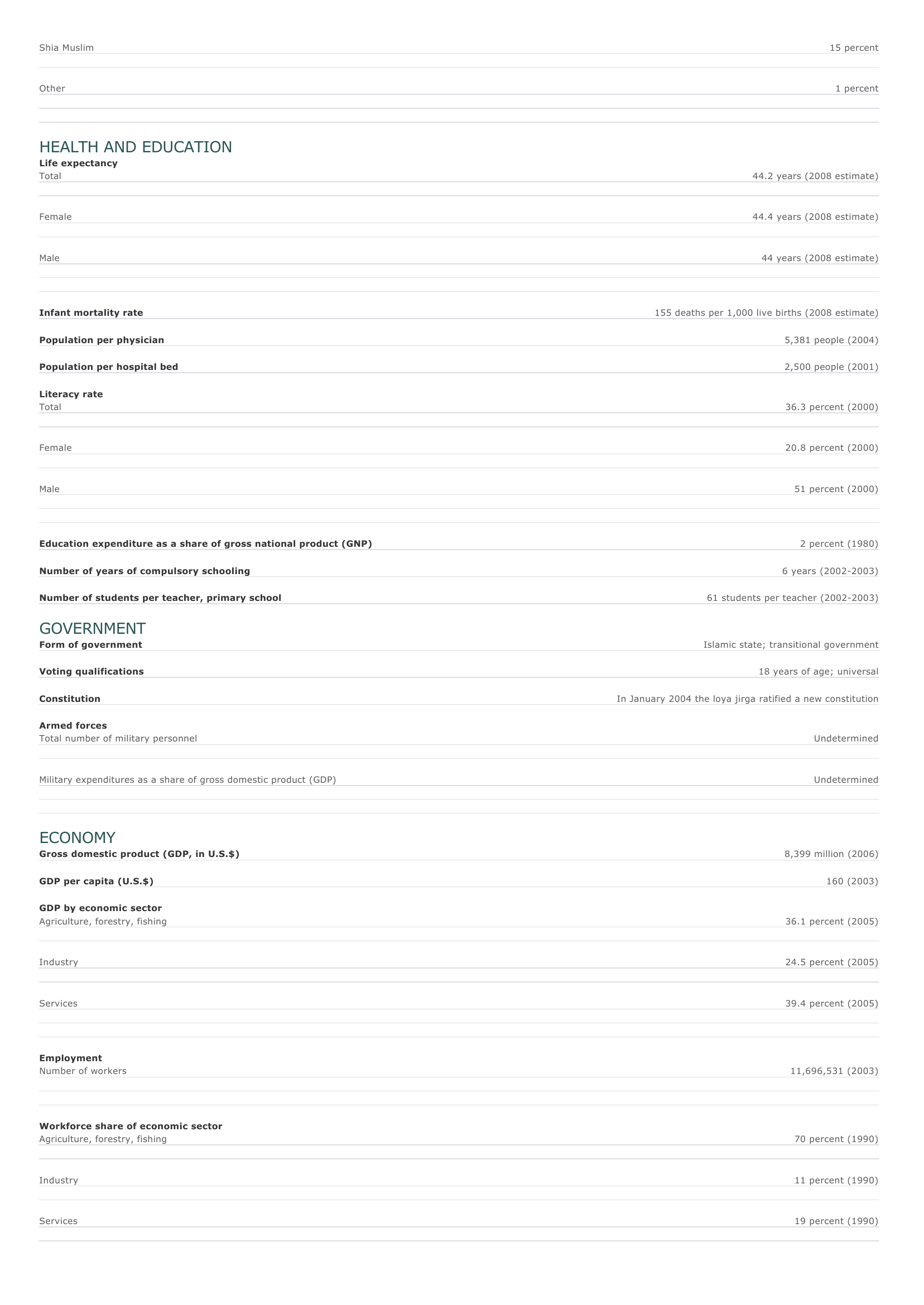
Afghanistan Facts and Figures. BASIC FACTS Official name Capital Area Transitional Islamic State of Afghanistan Kabul 652,225 sq km 251,825 sq mi PEOPLE Population 32,738,376 (2008 estimate) Population growth Population growth rate 2.63 percent (2008 estimate) Projected population in 2025 50,252,227 (2025 estimate) Projected population in 2050 81,933,479 (2050 estimate) Population density 51 persons per sq km (2008 estimate) 131 persons per sq mi (2008 estimate) Urban/rural distribution Share urban 23 percent (2003 estimate) Share rural 77 percent (2003 estimate) Largest cities, with population Kabul 2,956,000 (2003 estimate) Kandah? r 225,500 (1988 estimate) H er ?t 177,300 (1988 estimate) Ethnic groups Pashtun 38 percent Tajik 25 percent Hazara 19 percent Minor ethnic groups (Chahar Aimaks, Turkmen, Baluch, Nuristani, and others) 12 percent Uzbek 6 percent Languages Afghan Persian (Dari) 50 percent Pashto 35 percent Turkic languages (primarily Uzbek and Turkmen) 11 percent 30 minor languages (primarily Baluchi and Pashai) 4 percent Many people are multilingual Religious affiliations Sunni Muslim 84 percent Shia Muslim O ther 15 percent 1 percent HEALTH AND EDUCATION Life expectancy Total 44.2 years (2008 estimate) Female 44.4 years (2008 estimate) Male Infant mortality rate 44 years (2008 estimate) 155 deaths per 1,000 live births (2008 estimate) Population per physician 5,381 people (2004) Population per hospital bed 2,500 people (2001) Literacy rate Total 36.3 percent (2000) Female 20.8 percent (2000) Male Education expenditure as a share of gross national product (GNP) Number of years of compulsory schooling Number of students per teacher, primary school 51 percent (2000) 2 percent (1980) 6 years (2002-2003) 61 students per teacher (2002-2003) GOVERNMENT Form of government Islamic state; transitional government Voting qualifications 18 years of age; universal Constitution In January 2004 the loya jirga ratified a new constitution Armed forces Total number of military personnel Undetermined Military expenditures as a share of gross domestic product (GDP) Undetermined ECONOMY Gross domestic product (GDP, in U.S.$) GDP per capita (U.S.$) 8,399 million (2006) 160 (2003) GDP by economic sector Agriculture, forestry, fishing 36.1 percent (2005) I ndustry 24.5 percent (2005) Services 39.4 percent (2005) Employment Number of workers 11,696,531 (2003) Workforce share of economic sector Agriculture, forestry, fishing 70 percent (1990) I ndustry 11 percent (1990) Services 19 percent (1990) Unemployment rate National budget (U.S.$) Total revenue Total expenditure Not available 876 million (2005) 457.3 million (2005) Monetary unit 1 afghani (AF), consisting of 100 puls Major trade partners for exports Pakistan, India, Finland, Germany, Belgium Major trade partners for imports Pakistan, South Korea, Japan, United States, Germany ENERGY, COMMUNICATIONS, AND TRANSPORTATION Electricity production Electricity from thermal sources 30.39 percent (2003 estimate) Electricity from hydroelectric sources 69.61 percent (2003 estimate) Electricity from nuclear sources 0 percent (2003 estimate) Electricity from geothermal, solar, and wind sources 0 percent (2003 estimate) Number of radios per 1,000 people 132 (1997) Number of telephones per 1,000 people 3 (2005) Number of televisions per 1,000 people 12 (2000 estimate) Number of Internet hosts per 10,000 people 0 (2000) Daily newspaper circulation per 1,000 people 6 (1996) Number of motor vehicles per 1,000 people Paved road as a share of total roads 2.3 (1997) 24 percent (2004) SOURCES Basic Facts and People sections Area data are from the statistical bureaus of individual countries. Population, population growth rate, and population projections are from the United States Census Bureau, International Programs Center, International Data Base (IDB) (www.census.gov). Urban and rural population data are from the Food and Agriculture Organization (FAO) of the United Nations (UN), FAOSTAT database (www.fao.org). Largest cities population data and political divisions data are from the statistical bureaus of individual countries. Ethnic divisions and religion data are largely from the latest Central Intelligence Agency (CIA) World Factbook and from various country censuses and reports. Language data are largely from the Ethnologue, Languages of the World, Summer Institute of Linguistics International (www.sil.org). Health and Education section Life expectancy and infant mortality data are from the United States Census Bureau, International Programs Center, International database (IDB) (www.census.gov). Population per physician and population per hospital bed data are from the World Health Organization (WHO) (www.who.int). Education data are from the United Nations Educational, Scientific and Cultural Organization (UNESCO) database (www.unesco.org). Government section Government, independence, legislature, constitution, highest court, and voting qualifications data are largely from various government Web sites, the latest Europa World Yearbook, and the latest Central Intelligence Agency (CIA) World Factbook. The armed forces data is from Military Balance. Economy section Gross domestic product (GDP), GDP per capita, GDP by economic sectors, employment, and national budget data are from the World Bank database (www.worldbank.org). Monetary unit, agriculture, mining, manufacturing, exports, imports, and major trade partner information is from the statistical bureaus of individual countries, latest Europa World Yearbook, and various United Nations and International Monetary Fund (IMF) publications. Energy, Communication, and Transportation section Electricity information is from the Energy Information Administration (EIA) database (www.eia.doe.gov). Radio, telephone, television, and newspaper information is from the United Nations Educational, Scientific and Cultural Organization (UNESCO) database (www.unesco.org). Internet hosts, motor vehicles, and road data are from the World Bank database (www.worldbank.org). Note Figures may not total 100 percent due to rounding. Microsoft ® Encarta ® 2009. © 1993-2008 Microsoft Corporation. All rights reserved.





